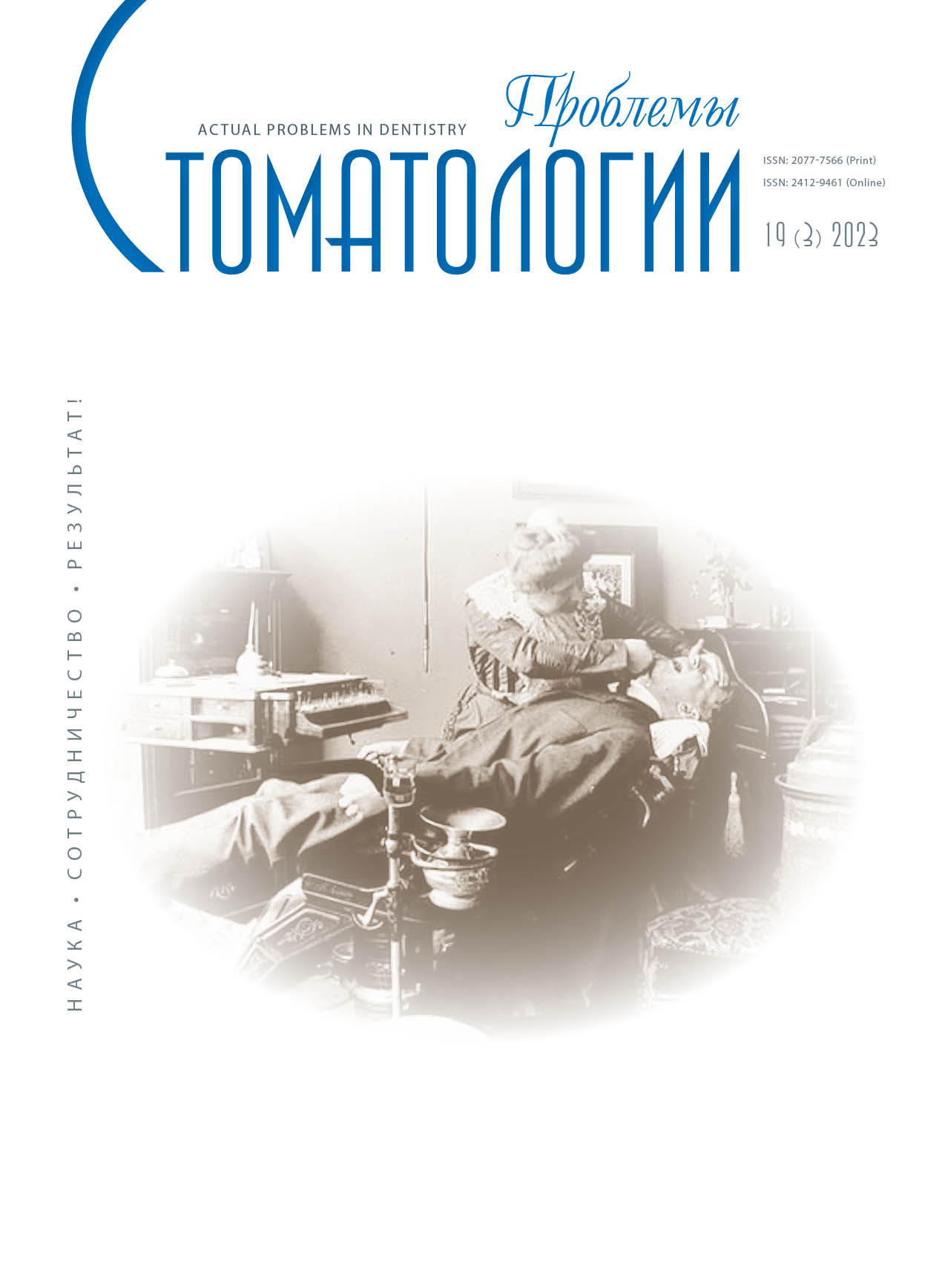Saint Petersburg, St. Petersburg, Russian Federation
Velikiy Novgorod, Veliky Novgorod, Russian Federation
Saint Petersburg, St. Petersburg, Russian Federation
City Dental Clinic No. 33 (Chief Physician)
Saint Petersburg, St. Petersburg, Russian Federation
UDC 616
The subject of the research is implant prosthetics. The goal is to increase the efficiency of implant prosthetics by optimizing the design of the prosthesis. Methodology. 131 patients (57 men and 74 women) aged from 60 to 82 years (mean age 68.3 ± 7.3 years) were examined. The patients were divided into 3 groups: group 1 – 36 patients (14 men and 22 women with an average age of 70.1 ± 5.4 years) with vertical distal implants without dorsal weight; group 2 – 44 people (19 men, 25 women with an average age of 69.4 ± 7.2 years) with inclined distal implants without dorsal weight; group 3 – 51 people (24 men and 27 women with an average age of 68.4 ± 6.8 years) with inclined distal implants, which also carried the dorsal body of the prosthesis with unilateral support on them. The condition of the peri-implant bone was assessed using 16 criteria obtained using clinical and instrumental research methods. The study of the distributions and magnitude of elastic stresses in the peri-implant bone was carried out using mathematical modeling using finite elements. Results. Identical results were obtained for the reaction of the peri-implant bone and mucous membrane of the peri-implant cuff, as well as the levels of preservation of implants and implant prostheses in the long term (2–3 years) in patients with different configurations of the distal parts of extended implant prostheses. Mathematical modeling by the finite element method also showed the non-criticality of the distribution of elastic stresses in the prosthesis, distal implant, compact and cancellous bone with different configurations of the distal parts of the prosthesis. Conclusion. Inclined implants, including those with additional load in the form of a dorsal body with unilateral support, can be quite widely used in elderly patients.
implant, prosthetics, dorsal support, final element, peri-implant bone
1. Rozov R.A., Kabanov M.Yu., Trezubov V.N. Utrata zven'ev zhevatel'nogo apparata - invalidnost' ili invalidizaciya? Uspehi gerantologii. 2021;2(34):232-238. [R.A. Rozov, M. YU. Kabanov, V.N. Trezubov. Loss of links in a chewing disorder - disability or disability? Advances in Gerontology. 2021;2(34):232-238. (In Russ.)]. https://doi.org/10.34922/AE.2021.34.2.007
2. Rozov R.A., Trezubov V.N., Urakov A.L. Individual'naya cifrovaya rekonstrukciya zhevatel'no-rechevogo apparata pri implantacionnom protezirovanii pacientov s polnoy poterey zubov. Rossiyskiy zhurnal biomehaniki. 2022;3:105-115. [R.A. Rozov, V.N. Trezubov, A.L. Urakov. Individual digital reconstruction of the masticatory-speech apparatus for implant prosthetics in patients with complete loss of teeth. Russian Journal of Biomechanics. 2022;3:105-115. (In Russ.)]. https://doi.org/10.15593/RZhBiomeh/2022.3.08
3. Rozov R.A., Higuchi K.U., Brunski Dzh., Trezubov V.N., Smerdov A.A., Mishnev M.L. Trehmernyy konechno-elementnyy analiz vliyaniya utraty dental'nogo implantata na raspredelenie napryazheniya v implantacionnom proteze nizhney chelyusti. Rossiyskiy zhurnal biomehaniki. 2023;3(27):24-35. [R.A. Rozov, K.U. Higuchi, D. Brunski, V.N. Trezubov, A.A. Smerdov, M.L. Mishnev. Three-dimensional finite element analysis of the effect of dental implant loss on stress distribution in a mandibular implant prosthesis. Russian Journal of Biomechanics. 2023;3(27):24-35. (In Russ.)]. DOI:https://doi.org/10.15593/RZhBiomech/2023.3.02
4. Trezubov V.N., Bulycheva E.A., Trezubov V.V., Rozov R.A. Predvaritel'noe zubnoe protezirovanie: rukovodstvo dlya vrachey stomatologov. Spb : Izdatel'stvo Chelovek. 2019:92. [V.N. Trezubov, E.A. Bulycheva, V.V. Trezubov, R.A. Rozov. Preliminary dental prosthetics: a guide for dentists. St. Petersburg : Publishing House Man. 2019:92. (In Russ.)]. https://doi.org/10.4103/1596-3519.240193
5. Trezubov V.N., Mishnev M.L., Parshin Yu.V., Modestov V.S., Yareha D.I. Eksperimental'noe izuchenie raspredeleniya uprugih napryazheniy v periimplantatnoy kosti pri zubnom protezirovanii. Rossiyskiy zhurnal biomehaniki. 2023;3(27):10-23. [V.N. Trezubov, M.L. Mishnev, Yu.V. Parshin, V.S. Modestov, D.I. Yarekha. Experimental study of the distribution of elastic stresses in the peri-implant bone during dental prosthetics. Russian Journal of Biomechanics. 2023;3(27):10-23. (In Russ.)]. DOI:https://doi.org/10.15593/RZhBiomech/2023.3.01
6. Trezubov V.N., Rozov R.A. Dekompensirovannyy zubnoy ryad (filosofskiy etyud). Parodontologiya. 2020;25(2):134-139. [V.N. Trezubov, R.A. Rozov. Decompensated dentition (philosophical study). Periodontology. 2020;25(2):134-139. (In Russ.)]. https://doi.org/10.33925/1683-3759-2020-25-2-134-139
7. Bevilacqua M., Tealdo T., Menini M., Pera F., Mossolov A., Drago C., Pera P. The influence of cantilever length and implant inclination on stress distribution in maxillary implant-supported fixed dentures // J. Prosthet. Dent. - 2010;105(1):5-13. https://doi.org/10.1016/s0022-3913(10)60182-5
8. Camargo B., Drummond L., Ozkomur A., Villarinho E., Rockenbach M., Teixeira E., Shinkai R. Implant Inclination and Cantilever Length Are Not Associated with Bone Loss in Fixed Complete Dentures: A Prospective Study // Int. J. Prosthodont. - 2019;32(1):17-19. https://doi.org/10.11607/ijp.6022
9. French D., Grandin H., Ofec R. Retrospective cohort study of 4,591 dental implants: Analysis of risk indicators for bone loss and prevalence of peri-implant mucositis and peri-implantitis // J. Periodontol. - 2019;90(7):691-700. https://doi.org/10.1002/jper.18-0236
10. Krennmair S., Weinlander M., Malck M., Forstner T. et al. Mandibular full-arch fixed prostheses supported on 4 implants with either axial or tilted distal implants: A 3-year prospective study // Clin. Implant Dent. Relat. Res. - 2016;18:1119-1133. https://doi.org/10.1111/cid.12419
11. Maló P., de Araujo Nobre M., Lopes A., Ferro A., Botto J. The All-on-4 treatment concept for the rehabilitation of the completely edentulous mandible: A longitudinal study with 10 to 18 years of follow-up // Clin. Implant. Dent. Relat. Res. - 2019;1:1-13. https://doi.org/10.1111/cid.12769
12. Mengel R., Wendt J., Peleska B. Prosthodontic Treatment Outcomes in Periodontally Compromised Patients: A 6- to 20-Year Long-Term Cohort Study // Int. J. Prosthodont. - 2019;32(2):153-161. https://doi.org/10.11607/ijp.5917
13. Menini M., Setti P., Pera F., Pesce P. Peri-implant Tissue Health and Bone Resorption in Patients with immediately loaded, implant-supported, full-arch Prostheses // Int. J. Prosthodont. - 2018;31(4):327-333. https://doi.org/10.11607/ijp.5567
14. Schwarz F., Schar A., Nelson K., Fretwurst T et al. Recommendations for implant-supported full-arch rehabilitations in edentulous patients: the oral reconstructions foundation consensus report // Int. J. Prosthodont. - 2021;34:8-20. https://doi.org/10.11607/ijp.consensusreport



















